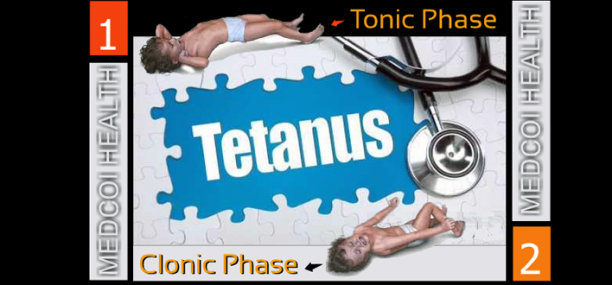TETANUS (СТОЛБНЯК)
Tetanus (lockjaw, СТОЛБНЯК, الكزاز) is a serious rare infection caused by Clostridium tetani (bacteria), it is characterized by its spastic syndrome (muscle spasms), that usually begin in the jaw and then progress to the rest of the body muscles, if not treated tetanus can lead to acute respiratory failure and death.
Pathogen – Clostridium tetani
Epidemiology
The source of infection – animals
Mechanism of transmission – by means of contact, the infection occurs most often when infected instruments and/or contaminated soil penetrate the wounds. Moreover, post-operative, and post-natal tetanus are possible.
Clinical picture
The incubation period ranges between 5-14 days or even more. Start acute.
Spastic syndrome
Trismus or tonic tension of the jaw muscles (masticatory muscles), seizures of facial muscles medically termed as sardonic smile, difficulty swallowing with spasm of the pharyngeal muscles, tonic rigidity of large groups of muscles, and severe pain in them. On the onset of muscle hypertonicity, a form of general tetanic convulsions develop, these general convulsions last from a few seconds to several minutes until the patient enters the state of opisthotonos (опистотонуса, التشنج الظهري, a sharp spasm of the muscles of the back, in which the patient’s body is curved in the form of an arch).
Prolonged seizure can lead to asphyxia (acute respiratory failure).
Complications: pneumonia, sepsis, muscle rupture, dislocation of joints, asphyxia.
Differential diagnosis
The differential diagnosis is carried out with tetany, Rabies, hysteria, epileptic seizures, meningitis, encephalitis, retropharyngeal abscess, strychnine poisoning, and skull fracture.
Laboratory diagnosis is limited.
Treatment
Etiotropic therapy
In the presence of fractional hypersensitivity, therapy consists of a single injection of a specific tetanus toxoid intramuscularly at a dose of 50 -150 thousand ME, and single administration of a specific dose gammaglobulin 900 ME (6 ml).
Pathogenetic therapy
Anticonvulsant drugs (neuroleptics), detoxification products
In severe forms with the development of acute respiratory failure – muscle relaxants and transfer to the ventilator.
Symptomatic therapy
Cardiovascular agents and anti-coagulants
Prophylaxis
Prophylaxis and prevention in the presence of wound contamination is initiated via primary surgical treatment of wounds, administered 1.0 (20 units) of tetanus anatoxin and ME 3000 of tetanus toxoid in non-vaccinated patients.
Vaccination
For vaccination against tetanus only 0.5 ml (10 units) of tetanus anatoxin is administered.
Verified by: Dr.Diab (January 7, 2017)
Citation: Dr.Diab. (January 7, 2017). Tetanus Epidemiology clinic and treatment. Medcoi Journal of Medicine, 4(2). urn:medcoi:article16262.














There are no comments yet
Or use one of these social networks